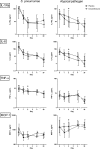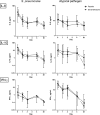Dexamethasone downregulates the systemic cytokine response in patients with community-acquired pneumonia
- PMID: 22855392
- PMCID: PMC3428389
- DOI: 10.1128/CVI.00423-12
Dexamethasone downregulates the systemic cytokine response in patients with community-acquired pneumonia
Abstract
The influence of adjunctive corticosteroids on the cytokine response in community-acquired pneumonia (CAP) is largely unknown. In this study, we analyzed the effect of dexamethasone on the cytokine response in patients with CAP and evaluated whether this effect is dependent on the causative microorganism. We hypothesized that dexamethasone has a larger effect on the cytokine response in patients with pneumococcal pneumonia than in patients with pneumonia caused by an atypical bacterium. A total of 304 hospitalized, nonimmunocompromised patients with CAP were randomized to an adjunctive 4-day course of 5 mg dexamethasone once a day (n = 151) or a placebo (n = 153). Serum concentrations of interleukin-1 receptor antagonist (IL-1Ra), IL-6, IL-8, IL-10, IL-17, tumor necrosis factor alpha (TNF-α), gamma interferon (IFN-γ), macrophage inflammatory protein-1 alpha (MIP-1α), and monocyte chemotactic protein-1 (MCP-1) were measured on days 0, 1, 2, and 4 and at a control visit. Overall, the concentrations of IL-6 (P < 0.01), IL-8 (P < 0.01), MCP-1 (P < 0.01), and TNF-α (P < 0.01) were significantly lower on day 2 in the dexamethasone group than in the placebo group. In patients with pneumococcal pneumonia (n = 72), both treatment groups showed a rapid decrease of cytokine concentrations; only the concentration of TNF-α (P = 0.05) was significantly lower in the dexamethasone group on day 2. In patients with CAP caused by an atypical pathogen (Legionella pneumophila, Chlamydophila species, Coxiella burnetii, or Mycoplasma pneumoniae; n = 58), IL-1Ra (P < 0.01), IL-6 (P < 0.01), and MCP-1 (P = 0.03) decreased more rapidly in the dexamethasone group than in the placebo group. In conclusion, dexamethasone downregulates the cytokine response during CAP. This effect seems to be dependent on the causative microorganism. This study provides insight into which patients with CAP might benefit most from adjunctive dexamethasone.
Figures



Similar articles
-
Biomarkers define the clinical response to dexamethasone in community-acquired pneumonia.J Infect. 2012 Jul;65(1):25-31. doi: 10.1016/j.jinf.2012.03.008. Epub 2012 Mar 9. J Infect. 2012. PMID: 22410382 Clinical Trial.
-
Serum cytokine profile contributes to discriminating M. pneumoniae pneumonia in children.Cytokine. 2016 Oct;86:73-78. doi: 10.1016/j.cyto.2016.07.018. Epub 2016 Jul 29. Cytokine. 2016. PMID: 27475111
-
Expression of pro-inflammatory cytokines by flow-sorted alveolar macrophages in severe pneumonia.Eur Respir J. 1998 Mar;11(3):534-41. Eur Respir J. 1998. PMID: 9596098
-
Community-acquired pneumonia related to intracellular pathogens.Intensive Care Med. 2016 Sep;42(9):1374-86. doi: 10.1007/s00134-016-4394-4. Epub 2016 Jun 8. Intensive Care Med. 2016. PMID: 27276986 Review.
-
Placebo-controlled trials of treatments for community-acquired pneumonia: review of the literature and discussion of feasibility and potential value.Clin Infect Dis. 2008 Dec 1;47 Suppl 3:S145-9. doi: 10.1086/591396. Clin Infect Dis. 2008. PMID: 18986281 Review.
Cited by
-
Potential of immunomodulatory agents as adjunct host-directed therapies for multidrug-resistant tuberculosis.BMC Med. 2016 Jun 15;14:89. doi: 10.1186/s12916-016-0635-1. BMC Med. 2016. PMID: 27301245 Free PMC article. Review.
-
Latent class analysis-based subgroups and response to corticosteroids in hospitalised community-acquired pneumonia patients: a validation study.ERJ Open Res. 2023 Mar 6;9(2):00577-2022. doi: 10.1183/23120541.00577-2022. eCollection 2023 Mar. ERJ Open Res. 2023. PMID: 36891066 Free PMC article.
-
Postoperative neurocognitive disorders in the elderly: how can we stop the harm? A literature review.Front Med (Lausanne). 2025 Mar 6;12:1525639. doi: 10.3389/fmed.2025.1525639. eCollection 2025. Front Med (Lausanne). 2025. PMID: 40115783 Free PMC article. Review.
-
TNF Drives Monocyte Dysfunction with Age and Results in Impaired Anti-pneumococcal Immunity.PLoS Pathog. 2016 Jan 14;12(1):e1005368. doi: 10.1371/journal.ppat.1005368. eCollection 2016 Jan. PLoS Pathog. 2016. PMID: 26766566 Free PMC article.
-
Clinical characteristics of refractory mycoplasma pneumoniae pneumonia in children treated with glucocorticoid pulse therapy.BMC Infect Dis. 2021 Jan 28;21(1):126. doi: 10.1186/s12879-021-05830-4. BMC Infect Dis. 2021. PMID: 33509121 Free PMC article.
References
-
- Annane D, et al. 2002. Effect of treatment with low doses of hydrocortisone and fludrocortisone on mortality in patients with septic shock. JAMA 288:862–871 - PubMed
-
- Bollaert PE, et al. 1998. Reversal of late septic shock with supraphysiologic doses of hydrocortisone. Crit. Care Med. 26:645–650 - PubMed
-
- Briegel J, et al. 1999. Stress doses of hydrocortisone reverse hyperdynamic septic shock: a prospective, randomized, double-blind, single-center study. Crit. Care Med. 27:723–732 - PubMed
-
- Endeman H, et al. 2011. Systemic cytokine response in patients with community-acquired pneumonia. Eur. Respir. J. 37:1431–1438 - PubMed
-
- Fine MJ, et al. 1997. A prediction rule to identify low-risk patients with community-acquired pneumonia. N. Engl. J. Med. 336:243–250 - PubMed
Publication types
MeSH terms
Substances
LinkOut - more resources
Full Text Sources
Research Materials
Miscellaneous

